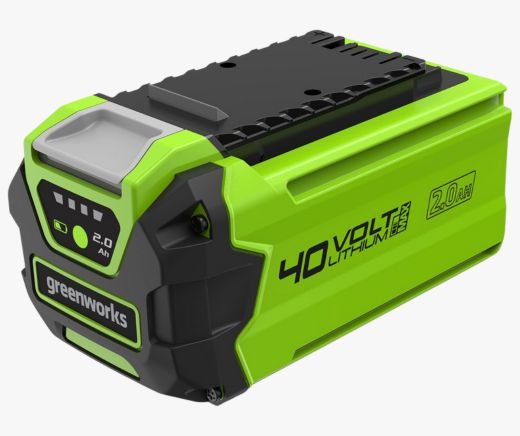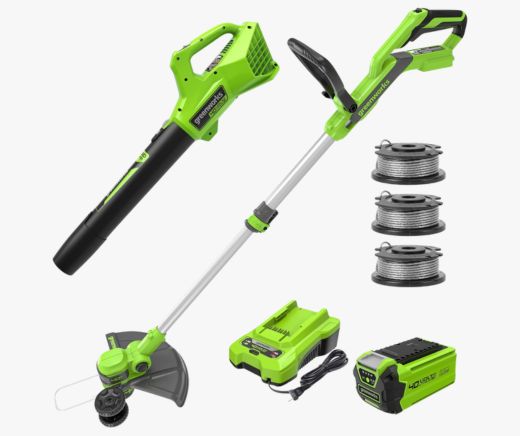Ever try to mow the lawn, only to find your Greenworks 40V battery won’t charge—even after a full night on the charger?
It’s annoying, but you’re not the only one. I’ve run into this too, mostly after leaving the battery in the garage over winter. After years of using cordless tools and testing a few fixes, I’ve figured out what causes it—and how to fix it.
Let’s go over what might be wrong and how to get it working fast, without wasting time or money.

Greenworks 40V 2.0Ah Lithium-Ion Battery
Table of Contents
Is Your Greenworks 40V Battery Really Not Charging?
Before you panic, take a minute to check a few things. The problem might not be the battery at all.
- Does the battery show any lights when it’s on the charger?
If it’s dark, it might not be making good contact. Or it could be too drained to light up. - Do the charger lights blink red or green?
Blinking red often means a fault or it’s too hot or cold.
Solid green means it’s charged.
Blinking green means it’s still charging. - Is your tool still dead, even with a battery that looks charged?
The battery might be bad. Or the tool’s contacts could be dirty.
Here’s what to check first: look at the charger lights. Make sure the terminals are clean. Feel if the battery is too hot or too cold.
I’ve had this happen in Michigan winters. Cold temps or a bit of dust can stop the whole thing from working. A fast check can save you a big headache.
Common Reasons Your Greenworks 40V Battery Isn’t Charging
If your Greenworks 40V battery won’t charge, don’t give up yet. It might not be dead. Many issues are simple to fix. Let’s look at the most common ones.

a. Dirty or Rusty Battery Contacts
Dust or rust on the battery ends can block the charger. This often happens after storing tools all winter.
What to do:
- Unplug the charger and take out the battery.
- Wipe the contacts with a soft cloth or old toothbrush.
- If you see rust, use a cotton swab with rubbing alcohol.
- Let it dry fully before charging.
Clean contacts can bring a “dead” battery back to life.
b. Battery Is Too Hot or Too Cold
These batteries don’t like heat or cold. If it’s too warm or too cold, it won’t charge. This helps keep the battery safe.
Signs to watch:
- Blinking red light on the charger.
- Battery left in a hot garage or cold shed.
Fix it:
- Bring it inside.
- Let it sit at room temp (60–75°F) for 30 to 60 minutes.
- Try charging again.
c. Battery Sat Too Long (Deep Discharge)
If your battery sat for months, it may be too empty to charge. This can happen after winter.
What you’ll see:
- No lights on the battery.
- Charger does nothing.
Try this:
- Leave it on the charger for a few hours.
- If that fails, try a “jump start” using another full battery (we’ll show how in the next part).
d. Bad Charger or Port
Sometimes, the charger is the problem—not the battery. I had one die after two years of weekend use.
How to test:
- Try another battery on your charger.
- Try your battery on a different charger.
- Check your wall outlet or extension cord.
e. Dead or Worn-Out Battery
Sadly, batteries don’t last forever. If it’s a few years old, it may be done.
Signs it’s time to replace:
- Won’t charge at all.
- Clicking sounds, but no charging.
- Loses power fast, even after a full charge.
Most Greenworks batteries last 2 to 3 years with normal use. If yours is still under warranty, check with Greenworks before buying a new one.
My Story: What Worked and What Didn’t

Greenworks 40V 13-Inch Cordless String Trimmer Edger and Leaf Blower Combo Kit
The first time my Greenworks 40V battery wouldn’t charge, I thought it was dead. It had sat in my garage all winter (thanks, Michigan cold). I put it on the charger—nothing. No lights. No sound. Just silence.
At first, I blamed the charger. But then I saw a blinking red light. I later learned that means the battery is too hot, too cold, or there’s a fault.
Here’s what I tried—and what finally helped:
What didn’t work:
- I tried to charge it over and over. No change.
- I switched outlets and used a power strip. Still nothing.
What did work:
- I brought the battery inside. It felt ice cold.
- I let it sit at room temp for an hour.
- I cleaned the contacts with a soft toothbrush and rubbing alcohol.
- They didn’t look dirty—but it helped.
Then I tried the charger again. After a minute… blinking green light!
It charged fully and worked like new in my mower.
Later, I had another battery that wouldn’t charge. It was deeply drained. This time, I used a trick: the “jump start” method. I connected it to a fully charged battery with wires for a few seconds. That woke it up! Not an official fix, but it worked.
One more tip: Older chargers don’t always recover drained batteries. I’ve had better luck with newer models. If you live in a cold state like I do, store your batteries indoors. That simple step saved me a lot of trouble.
Easy Fixes to Try at Home

If your Greenworks 40V battery won’t charge, don’t stress. Here’s the quick list I use:
1. Clean the Battery Contacts
- Unplug the charger.
- Take the battery out.
- Wipe the metal parts with a dry cloth or soft brush.
- For deeper cleaning, use rubbing alcohol on a cotton swab.
- Let it dry before trying again.
2. Warm It Up (or Cool It Down)
- Cold or heat can stop charging.
- Bring the battery inside.
- Let it sit for 30–60 minutes.
- Best temp is 60–75°F.
- Try again once it’s at room temp.
3. Try Another Charger or Outlet
- Use a different wall outlet (skip the power strip).
- Test another battery in your charger.
- Or try your battery on a different charger.
- This tells you if the battery or the charger is bad.
4. Wake a Dead Battery
- If it sat too long, it may be “asleep.”
- Leave it on the charger for at least an hour.
- If still nothing, try this:
Jump-start method:
- Use a charged Greenworks 40V battery.
- Connect positive to positive, and negative to negative.
- Hold for just a few seconds.
Be careful. Only try this if you’re sure you know what you’re doing.
These steps have saved my batteries more than once. Most of the time, they weren’t dead—they just needed some care. If you live where winters are cold, store batteries inside. Then check contacts in spring. That one habit can make a big difference.
When to Replace the Battery or Call Support
If your Greenworks 40V battery still won’t charge, even after trying all the steps, it might be time to move on.
How to tell if it’s really dead:
- No lights at all, even after warming it up and cleaning it.
- It “charges” but dies in a few minutes.
- You’ve tried a new charger and outlet—still nothing.
- Jump-starting didn’t help or only worked once.
How long do they last?
In my experience, most Greenworks 40V batteries last 2 to 3 years with regular weekend use.
If you only mow a small yard, you might get 4 years.
If you use more tools (like a chainsaw or blower), it wears out faster.
Check your warranty
Greenworks batteries often have a 2- to 3-year warranty.
Check your original box or receipt to see the exact length.
How to reach Greenworks support (U.S.):
- Call: 1-888-909-6757 (Weekdays, 9 a.m.–5 p.m. EST)
- Or go online: Fill out the form at greenworkstools.com
What to say when you call:
- Battery model number (on the label)
- Serial number (small but important)
- Clear message like:
“My Greenworks 40V battery isn’t charging. I tried another charger, cleaned the contacts, and let it warm up. Still no lights.”
Be clear and polite. I’ve had support walk me through steps—or even send a new one when it was still under warranty.
Tips to Keep Your Greenworks 40V Battery Working Longer
Over time, I’ve learned a few habits that help batteries last longer. Some of these saved me from buying new ones too soon.

Store It Right
Don’t leave it in a hot garage or freezing shed.
Keep it in a dry room inside—best between 60–75°F.
In the U.S., garages can get over 100°F in summer or drop below 32°F in winter. That kind of heat or cold wears batteries out fast.
Don’t Drain It All the Way
Try not to run it to 0%.
Charge it when it hits 20–30% left. That helps keep it healthy.
If you’re putting it away for winter, leave it about half full—not empty.
Clean the Contacts Often
Even when stored, dust and moisture can build up.
Wipe the terminals with a soft cloth or a bit of rubbing alcohol every few months. It takes one minute and can help a lot.
Use the Right Battery for the Tool
Don’t use a small battery in a big tool.
I once used a trimmer battery in a blower—it overheated fast.
Stick with the right size and type. Your battery (and tool) will thank you.
Read More: Greenworks Mower Not Starting?
Conclusion
If your Greenworks 40V battery won’t charge, don’t worry. Most problems are easy to fix. I’ve had the same issue more than once. Cold winters and dusty shelves can mess with your battery—but a little care goes a long way.
We’ve covered the key steps:
- Check the lights on the charger
- Clean the contacts
- Make sure the battery isn’t too hot or cold
- Try the jump-start trick if needed
These tips have saved me time and money. Most batteries aren’t dead—they just need help.
What helped me most? I started keeping my batteries indoors during winter. I also check them before spring. That one habit has made a big difference.
If your battery still won’t charge, don’t feel bad. They wear out after a few years. That’s normal. Most Greenworks batteries last about 2–3 years, depending on how much you use them.
Got a tip that worked for you? Or a question I didn’t cover? Leave a comment! I’d love to hear what helped—or what you’re still stuck on. We can all learn from each other. Sometimes one small tip makes all the difference.
FAQs for Greenworks 40V Battery Not Charging
Why is my Greenworks 40V battery not charging?
It may not charge because the charger is bad, the battery contacts are dirty, or the battery is too hot or cold. Let it sit at room temp and try again.
How do I reset a Greenworks 40V battery that won’t charge?
Take the battery off the charger. Press and hold its power button for 5 seconds. Then put it back on the charger. This may fix a small error.
Can extreme temperatures stop my Greenworks 40V battery from charging?
Yes. If it’s too hot or too cold, it won’t charge. Let it sit at room temp (60–75°F) for 30 minutes before trying again.
What does a red flashing light on the Greenworks charger mean?
It means there’s a charging problem. Check for dirt or damage on the battery. Make sure the battery is seated tight in the charger.
When should I replace my Greenworks 40V battery?
If it won’t charge after trying everything or dies fast, it may be worn out. Most last 2 to 3 years with normal use.

